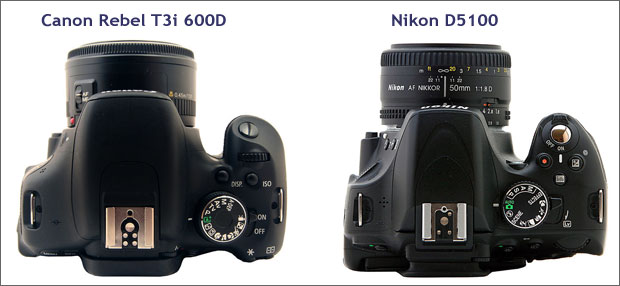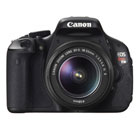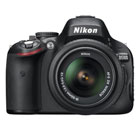Canon T3i 600D vs Nikon D5100
This page seeks to explain some of the less obvious differences between the Canon T3i 600D vs the Nikon D5100.
Before I spent time using both cameras, I had a hard time seeing any substantive differences between the two.
They both have flexible LCD screens, live view modes and plenty of autofocus points.
Both Canon and Nikon have a lont-standing reputation for image quality so I was not expecting to see any big differences there.
Once you've ruled out the obvious differences, you have to dig deeper: what is it that really sets these cameras apart from each other? Which lesser feature does one have that the other lacks?
That's what we'll try to figure out in the rest of this Canon T3i 600D vs Nikon D5100 comparison.
Features
Let's begin with the obvious: the list of features available on each camera.
The following table should illustrate what I mentioned above — just by comparing high-level features, it's pretty hard to decide if one is "better" than the other.
I've highlighted any column where there's a difference between the two cameras.
| CANON T3i (600D) | NIKON D5100 | |
| Release Date | March 2011 | April 2011 |
|---|---|---|
| List Price (USD) | $ 750 (with 18-55mm lens) | $ 750 (with 18-55mm lens) |
| Megapixels | 18.0 | 16.2 |
| Stabilization | In Lens | In Lens |
| Memory Card | SD / SDHC / SDXC | SD / SDHC / SDXC |
| Max. Shutter Speed | 1/4000 | 1/4000 |
| Max. Photo Capture | 3.7 per second | 4 per second |
| ISO Range | 100 to 12800 | 100 to 25600 |
| Movie Modes | Quicktime MOV (H.264) 1920 x 1080p (30/25/24 fps) 1280 x 720p (60/50 fps) 640 x 480 (60/50 fps) | H.264 1920 x 1080p (30/25/24 fps) 1280 x 720p (30/25/24 fps) 640 x 480 (30/25 fps) |
| LCD | Flexible 3in (1.04 mil dots) | Flexible 3in (921,000 dots) |
| Viewfinder | Pentamirror (95% coverage) | Pentamirror (95% coverage) |
| Autofocus | 9 point | 11 point |
| Face Detect AF | Yes | No |
| Sensor Dimensions | 22.2 x 14.8 (1.6x crop factor) | 23.1 x 15.4 (1.5x crop factor) |
| HDMI Port | Yes | Yes |
| Live View | Yes | Yes |
| Built-in Flash | Yes (Sync: 1/200) | Yes (Sync: 1/200) |
| Compatible Lenses | All Canon EF and EF-S | Nikon AF-I and AF-S |
| Dimensions | 5.1 x 3.9 x 2.9in 129 x 98 x 75mm | 5.0 x 3.8 x 3.1in 128 x 96 x 79mm |
| Weight | 18.7oz (530g) | 18oz (510g) |
Autofocus and Lens Compatibility
When comparing the Canon T3i 650D vs the Nikon D5100, the most notable difference has to do with the location of the autofocus motor.
- The Canon T3i 600D autofocus motor is built into the camera body
- The Nikon D5100 has NO autofocus motor
So what? What difference does this make?
Here's the key: older Nikon lenses will be manual focus only when used on the D5100, while all Canon EF and EF-S lenses will autofocus on the T3i 600D.
Clearly if you're just getting started in the world of DSLR photography, this is not a concern. When you get your D5100, just get a newer Nikon AF-S lens to go with it and you'll be fine.
Just recognize that you can't go to a camera swap meet and get some older Nikon lenses and expect them to autofocus with the D5100.
By contrast, a huge number of Canon EF, EF-S and third party lenses (made by Tamron, Tokina and Sigma) will autofocus just fine with the T3i 600D.
This provides you with some more flexibility when it comes to lens choices. It also means that you can save some money because you can buy lenses used and by third party companies that cost a lot less than those made by the camera manufacturers.
Camera Controls

When I use a new digital SLR, I start using it right away without taking a look at the manual.
No, I'm not just being stubborn male refusing to seek help — I'm actually interested to see how well I can use it without needing to read an in-depth explanation.
For me, the Canon is the clear winner in this category: clearly labeled buttons and controls make it pretty obvious which setting each one is responsible for.
Getting familiar with the Nikon D5100 involved a steeper learning curve, especially since the functions of some buttons can be assigned different settings.
I did eventually get the hang of changing settings on the D5100, but found the Canon T3i 600D to be much more intuitive right out of the box.
Access to Movie Mode
The way that you activate movie mode is quite different on the Canon T3i 600D vs the Nikon D5100 and can be a serious difference depending on how you use the camera.
I don't spend a lot of time in movie mode taking one video after another so that I can later merge them together into an independent short film.
Instead, I often find that I want to take a quick video as I'm in the middle of taking pictures, and then go right back to taking pictures again. Quick and easy activation of movie mode is pretty important for me.
Here's the difference:
- On the T3i 600D, you can ONLY activate movie mode by selecting movie mode using the main mode dial on the top of the camera
- On the Nikon D5100, you have to flip a lever to put the camera into live view mode, and then press a button to start and stop recording

The big flaw in Canon's approach is that the movie mode is on the opposite side of the mode dial from all the manual camera modes.
Here's an example to explain why I find it tedious to access the mode. Say that I'm taking pictures in Aperture Priority (Av) mode and I want to take a video:
- First, I have to spin the mode dial all the way around from Av mode to movie mode
- Once in movie mode, I capture several seconds of video
- To go back to shooting stills, I have to spin the mode dial from movie mode back to Av mode
By contrast, you can leave the Nikon D5100 in any mode you want, activate live view, shoot some video and then go right back to shooting stills. The transition between the two modes is much more seamless.
It's also worth noting that Canon's upgrade to the T3i — the Canon Rebel T4i 650D — allows you to activate movie mode with the flick of a lever. It's a HUGE improvement (for me at least) over the T3i 600D.
Wireless Flash

If you're the type of person who avoids the use of flash at all possible costs, then read no further.
However, if you'd like to dramatically improve the results you get when you DO use a flash, this section of this Canon T3i 600D vs Nikon D5100 comparison may be of use to you.
One of the easiest ways to get better result from flash photography is to move the flash OFF the camera body.
When the light from flash hits your subject from an ANGLE (side, top, rear) it is immediately more interesting than on-camera flash.
You can achieve off-camera flash using extension cords that tether the flash to the camera, but in this day and age wireless flash triggering is the way to go.
Just like wireless internet, external flash units can receive signals from the camera body to fire when you take a picture.
The Canon T3i 600D has this capability, the D5100 does not.
When you pop up the built-in flash on the T3i 600D, it acts as a wireless trigger for other flash units. The built-in flash can either contribute light to the scene, or set so that it just triggers other flash units.
You can achieve wireless off-camera flash with the D5100, but it's going to require more gear and will cost quite a bit more.
More Information
While I've tried to be as objective as possible in my comparison above, some of the differences that I've called out have a lot to do with how I tend to use cameras.
If you use your DSLR differently, then some issues that I label as weaknesses you may see as strengths.
You can read another comparison of the Canon T3i 600D vs the Nikon D5100 at Techcrunch to get a different point of view.
In the end, the conclusions of that review are about the same as mine: these are two extremely comparable cameras, and — provided you have the willingness to learn how they work — you can take fantastic photos and videos with either one.
For in-depth information about each camera, check out my Canon Rebel T3i 600D review or the Nikon D5100 review.

|





